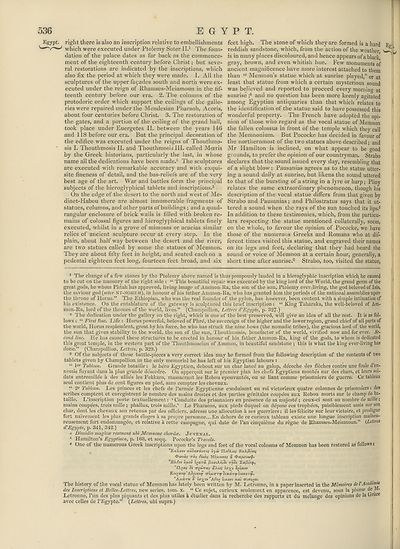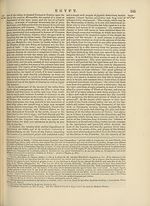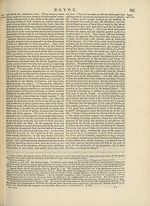Encyclopaedia Britannica > Volume 8, DIA-England
(546) Page 536
Download files
Complete book:
Individual page:
Thumbnail gallery: Grid view | List view

536
EGYPT.
Kgjpt. right there is also an inscription relative to embellishments
which were executed under Ptolemy Soter II.1 The foun¬
dation of the palace dates as far back as the commence¬
ment of the eighteenth centuiy before Christ; but seve¬
ral restorations are indicated by the inscriptions, which
also fix the period at which they were made. 1. All the
sculptures of the upper facades south and north were ex¬
ecuted under the reign of llhamses-Meiamoun in the fif¬
teenth century before our era. 2. The columns of the
protodoric order which support the ceilings of the galle¬
ries were repaired under the Mendesian Pharaoh, Acoris,
about four centuries before Christ. 3. The restoration of
the gates, and a portion of the ceiling of the grand hall,
took place under Euergetes II. between the years 146
and 118 before our era. But the principal decoration of
the edifice was executed under the reigns of Thouthmo-
sis I. Thouthmosis II. and Thouthmosis III. called Mceris
by the Greek historians, particularly the last, in whose
name all the dedications have been made.2 The sculptures
are executed with remarkable accuracy and with exqui¬
site fineness of detail, and the bas-reliefs are of the very
best age of the art. War and battles form the principal
subjects of the hieroglyphical tablets and inscriptions.3 4 5
On the edge of the desert to the north and west of Me-
dinet-Habou there are almost innumerable fragments of
statues, columns, and other parts of buildings ; and a quad¬
rangular enclosure of brick walls is filled with broken re¬
mains of colossal figures and hieroglyphical tablets finely
executed, whilst in a grove of mimosas or acacias similar
relics of ancient sculpture occur at every step. In the
plain, about half way between the desert and the river,
are two statues called by some the statues of Memnon.
They are about fifty feet in height, and seated each on a
pedestal eighteen feet long, fourteen feet broad, and six
feet high. The stone of which they are formed is a hard
reddish sandstone, which, from the action of the weather
is in many places discoloured, and hence appears of a black'
gray, brown, and even whitish hue. Few monuments of
ancient magnificence have more interest attached to them
than “ Memnon’s statue which at sunrise played,” or at
least that statue from which a certain mysterious sound
was believed and reported to proceed every morning at
sunrise ;4 and no question has been more keenly agitated
among Egyptian antiquaries than that which relates to
the identification of the statue said to have possessed this
wonderful property. The French have adopted the opi¬
nion of those who regard as the vocal statue of Memnon
the fallen colossus in front of the temple which they call
the Memnonium. But Pococke has decided in favour of
the northernmost of the two statues above described; and
Mr Hamilton is inclined, on what appear to be good
grounds, to prefer the opinion of our countryman. Strabo
declares that the sound issued every day, resembling that
of a slight blow; Pausanias agrees as to the statue utter¬
ing a sound daily at sunrise, but likens the sound uttered
to that of the bursting of a string in a lyre or harp; Pliny
relates the same extraordinary phenomenon, though his
description of the vocal statue differs from that given by
Strabo and Pausanias; and Philostratus says that it ut¬
tered a sound when the rays of the sun touched its lips.5
In addition to these testimonies, which, from the particu¬
lars respecting the statue mentioned collaterally, seem,
on the whole, to favour the opinion of Pococke, we have
those of the numerous Greeks and Romans who at dif¬
ferent times visited this statue, and engraved their names
on its legs and feet, declaring that they had heard the
sound or voice of Memnon at a certain hour, generally, a
short time after sunrise.0 Strabo, too, visited the statue,
1 The change of a few stones by the Ptolemy above named is thus pompously lauded in a hieroglyphic inscription which he caused
to be cut on the masonry of the right side : “ This beautiful repair was executed by the king lord of the World, the grand germ of the
great gods, he whom Plitah has approved, living image of Ammon-Ra, the son of the sun, Ptolemy ever-living, the god beloved of Isis,
the saviour god {soter NT-NOHEM), in honour of his father Ammon-Ra, who has granted him the periods of the national assemblies upon
the throne of Horus.” The Ethiopian, who was the real founder of the pylon, has however, been content with a simple intimation of
his existence. On the entablature of the gateway is sculptured this brief inscription : “ King Taharaka, the well-beloved of Am-
mon-lla, lord of the thrones of the world, lives.” (Champollion, Lettres d'Egypte, p. 1527-)
2 The dedication under the gallery on the right, which is one of the best preserved, will give an idea of all the rest. It is as fol¬
low's : “ First tine. Life : Horus powerful, beloved of Phrd, the sovereign of the higher and the lower region, grand chief of all parts of
the world, Horus resplendent, great by his force, he who has struck the nine bows (the nomadic tribes), the gracious lord of the world,
the sun that gives stability to the world, the son of the sun, Thouthmosis, benefactor of the world, vivified now and for ever. Se¬
cond line. He has caused these structures to be erected in honour of his father Ammon-Ra, king of the gods, to whom is dedicated
this great temple, in the western part of the Thouthmoseion of Ammon, in beautiful sandstone ; this is what the king ever-living has
done.” (Champollion, Lettres, p. 329.)
3 Of the subjects of these battle-pieces a very correct idea may be formed from the following description of the contents of two
tablets given by Champollion in the only memorial he has left of his Egyptian labours :
“ l6'" Tableau. Grande bataille: le he'ro Egyptien, debout sur un char lance au galop, de'coche des fleches centre une foule d’en-
nemis fuyant dans la plus grande desordre. On appercoit sur le premier plan les chefs Egyptiens monies sur des chars, et leurs sol-
dats entremeles a des allies les Fekkaro, massacrant les Robou epouvante's, ou se liant comme prisonniers de guerre. Ce tableau
seul contient plus de cent figures en pied, sans compter les chevaux.
“ 2e Tableau. Les princes et les chefs de Tarmee Egyptienne conduisent au roi victorieux quatre colonnes de prisonniers: des
scribes comptent et enregistrent le nombre des mains droites et des parties genitales coupdes aux Robou morts sur le champ de ba¬
taille. L’inscription porte textuellement: ‘ Conduite des prisonniers en presence de sa majeste ; ceux-ci sont au nombre de mille;
mains coupees, trois mille; phallus, trois mille.’ Le Pharaons, aux pieds duquel on depose ces trophdes, paisiblement assis sur son
char, dont les chevaux son retenus par des officiers, adresse une allocution a ses guerriers; il lesfelicite sur leur victoire, et prodigue
fort naivement les plus grands dloges a sa propre personne...En dehors de cecurieux tableau existe une longue inscription malheu-
reusement fort endommagee, et relative a cette campagne, qui date de Pan cinquieme du regne de Rhamses-Meiamoun.” (Lettres
d'Egypte, p. 341, 342.)
4 Dimidio magicce resonant ubi Memnone chordae. Jitvexal.
5 Hamilton’s Egyptiaca, p. 168, et seqq. Pococke’s Travels.
e One of the numerous Greek inscriptions upon the legs and feet of the vocal colossus of Memnon has been restored as follows:
“ExAi/av avhnirdvTo; \ya TloCkios BaX^lvo;
rug (itug Miumvog n Qa.y.iviaip.
‘HXAv oanu ioarZ (iurnXinilt rijSs Stcfitva,
'CLoag Ss •s'^wTa.g uXiog hr%t fyoyoii
Km^uvcjj 'Adyceya tri/UTru dixarai hiavTtv.
"Afiaru S’ hr%tv ‘'AHvq hr.otri xu) •xitruou.
The history of the vocal statue of Memnon has lately been written by M. Letronne, in a paper inserted in the Mtmoircs de PAcademy
des Inscriptions et Belles-Lettres, new series, tom. x. “ Ce sujet, curieux seulement en apparence, est devenu, sous la plume de M-
Letronne, Pun des plus piquants et des plus utiles h etudier dans la recherche des rapports et du me'lange des opinions de la Grece
avec celles de PEgypte.” {Lettres, ubi supra.)
EGYPT.
Kgjpt. right there is also an inscription relative to embellishments
which were executed under Ptolemy Soter II.1 The foun¬
dation of the palace dates as far back as the commence¬
ment of the eighteenth centuiy before Christ; but seve¬
ral restorations are indicated by the inscriptions, which
also fix the period at which they were made. 1. All the
sculptures of the upper facades south and north were ex¬
ecuted under the reign of llhamses-Meiamoun in the fif¬
teenth century before our era. 2. The columns of the
protodoric order which support the ceilings of the galle¬
ries were repaired under the Mendesian Pharaoh, Acoris,
about four centuries before Christ. 3. The restoration of
the gates, and a portion of the ceiling of the grand hall,
took place under Euergetes II. between the years 146
and 118 before our era. But the principal decoration of
the edifice was executed under the reigns of Thouthmo-
sis I. Thouthmosis II. and Thouthmosis III. called Mceris
by the Greek historians, particularly the last, in whose
name all the dedications have been made.2 The sculptures
are executed with remarkable accuracy and with exqui¬
site fineness of detail, and the bas-reliefs are of the very
best age of the art. War and battles form the principal
subjects of the hieroglyphical tablets and inscriptions.3 4 5
On the edge of the desert to the north and west of Me-
dinet-Habou there are almost innumerable fragments of
statues, columns, and other parts of buildings ; and a quad¬
rangular enclosure of brick walls is filled with broken re¬
mains of colossal figures and hieroglyphical tablets finely
executed, whilst in a grove of mimosas or acacias similar
relics of ancient sculpture occur at every step. In the
plain, about half way between the desert and the river,
are two statues called by some the statues of Memnon.
They are about fifty feet in height, and seated each on a
pedestal eighteen feet long, fourteen feet broad, and six
feet high. The stone of which they are formed is a hard
reddish sandstone, which, from the action of the weather
is in many places discoloured, and hence appears of a black'
gray, brown, and even whitish hue. Few monuments of
ancient magnificence have more interest attached to them
than “ Memnon’s statue which at sunrise played,” or at
least that statue from which a certain mysterious sound
was believed and reported to proceed every morning at
sunrise ;4 and no question has been more keenly agitated
among Egyptian antiquaries than that which relates to
the identification of the statue said to have possessed this
wonderful property. The French have adopted the opi¬
nion of those who regard as the vocal statue of Memnon
the fallen colossus in front of the temple which they call
the Memnonium. But Pococke has decided in favour of
the northernmost of the two statues above described; and
Mr Hamilton is inclined, on what appear to be good
grounds, to prefer the opinion of our countryman. Strabo
declares that the sound issued every day, resembling that
of a slight blow; Pausanias agrees as to the statue utter¬
ing a sound daily at sunrise, but likens the sound uttered
to that of the bursting of a string in a lyre or harp; Pliny
relates the same extraordinary phenomenon, though his
description of the vocal statue differs from that given by
Strabo and Pausanias; and Philostratus says that it ut¬
tered a sound when the rays of the sun touched its lips.5
In addition to these testimonies, which, from the particu¬
lars respecting the statue mentioned collaterally, seem,
on the whole, to favour the opinion of Pococke, we have
those of the numerous Greeks and Romans who at dif¬
ferent times visited this statue, and engraved their names
on its legs and feet, declaring that they had heard the
sound or voice of Memnon at a certain hour, generally, a
short time after sunrise.0 Strabo, too, visited the statue,
1 The change of a few stones by the Ptolemy above named is thus pompously lauded in a hieroglyphic inscription which he caused
to be cut on the masonry of the right side : “ This beautiful repair was executed by the king lord of the World, the grand germ of the
great gods, he whom Plitah has approved, living image of Ammon-Ra, the son of the sun, Ptolemy ever-living, the god beloved of Isis,
the saviour god {soter NT-NOHEM), in honour of his father Ammon-Ra, who has granted him the periods of the national assemblies upon
the throne of Horus.” The Ethiopian, who was the real founder of the pylon, has however, been content with a simple intimation of
his existence. On the entablature of the gateway is sculptured this brief inscription : “ King Taharaka, the well-beloved of Am-
mon-lla, lord of the thrones of the world, lives.” (Champollion, Lettres d'Egypte, p. 1527-)
2 The dedication under the gallery on the right, which is one of the best preserved, will give an idea of all the rest. It is as fol¬
low's : “ First tine. Life : Horus powerful, beloved of Phrd, the sovereign of the higher and the lower region, grand chief of all parts of
the world, Horus resplendent, great by his force, he who has struck the nine bows (the nomadic tribes), the gracious lord of the world,
the sun that gives stability to the world, the son of the sun, Thouthmosis, benefactor of the world, vivified now and for ever. Se¬
cond line. He has caused these structures to be erected in honour of his father Ammon-Ra, king of the gods, to whom is dedicated
this great temple, in the western part of the Thouthmoseion of Ammon, in beautiful sandstone ; this is what the king ever-living has
done.” (Champollion, Lettres, p. 329.)
3 Of the subjects of these battle-pieces a very correct idea may be formed from the following description of the contents of two
tablets given by Champollion in the only memorial he has left of his Egyptian labours :
“ l6'" Tableau. Grande bataille: le he'ro Egyptien, debout sur un char lance au galop, de'coche des fleches centre une foule d’en-
nemis fuyant dans la plus grande desordre. On appercoit sur le premier plan les chefs Egyptiens monies sur des chars, et leurs sol-
dats entremeles a des allies les Fekkaro, massacrant les Robou epouvante's, ou se liant comme prisonniers de guerre. Ce tableau
seul contient plus de cent figures en pied, sans compter les chevaux.
“ 2e Tableau. Les princes et les chefs de Tarmee Egyptienne conduisent au roi victorieux quatre colonnes de prisonniers: des
scribes comptent et enregistrent le nombre des mains droites et des parties genitales coupdes aux Robou morts sur le champ de ba¬
taille. L’inscription porte textuellement: ‘ Conduite des prisonniers en presence de sa majeste ; ceux-ci sont au nombre de mille;
mains coupees, trois mille; phallus, trois mille.’ Le Pharaons, aux pieds duquel on depose ces trophdes, paisiblement assis sur son
char, dont les chevaux son retenus par des officiers, adresse une allocution a ses guerriers; il lesfelicite sur leur victoire, et prodigue
fort naivement les plus grands dloges a sa propre personne...En dehors de cecurieux tableau existe une longue inscription malheu-
reusement fort endommagee, et relative a cette campagne, qui date de Pan cinquieme du regne de Rhamses-Meiamoun.” (Lettres
d'Egypte, p. 341, 342.)
4 Dimidio magicce resonant ubi Memnone chordae. Jitvexal.
5 Hamilton’s Egyptiaca, p. 168, et seqq. Pococke’s Travels.
e One of the numerous Greek inscriptions upon the legs and feet of the vocal colossus of Memnon has been restored as follows:
“ExAi/av avhnirdvTo; \ya TloCkios BaX^lvo;
rug (itug Miumvog n Qa.y.iviaip.
‘HXAv oanu ioarZ (iurnXinilt rijSs Stcfitva,
'CLoag Ss •s'^wTa.g uXiog hr%t fyoyoii
Km^uvcjj 'Adyceya tri/UTru dixarai hiavTtv.
"Afiaru S’ hr%tv ‘'AHvq hr.otri xu) •xitruou.
The history of the vocal statue of Memnon has lately been written by M. Letronne, in a paper inserted in the Mtmoircs de PAcademy
des Inscriptions et Belles-Lettres, new series, tom. x. “ Ce sujet, curieux seulement en apparence, est devenu, sous la plume de M-
Letronne, Pun des plus piquants et des plus utiles h etudier dans la recherche des rapports et du me'lange des opinions de la Grece
avec celles de PEgypte.” {Lettres, ubi supra.)
Set display mode to:
![]() Universal Viewer |
Universal Viewer | ![]() Mirador |
Large image | Transcription
Mirador |
Large image | Transcription
Images and transcriptions on this page, including medium image downloads, may be used under the Creative Commons Attribution 4.0 International Licence unless otherwise stated. ![]()
| Encyclopaedia Britannica > Encyclopaedia Britannica > Volume 8, DIA-England > (546) Page 536 |
|---|
| Permanent URL | https://digital.nls.uk/193330103 |
|---|
| Attribution and copyright: |
|
|---|
| Description | Ten editions of 'Encyclopaedia Britannica', issued from 1768-1903, in 231 volumes. Originally issued in 100 weekly parts (3 volumes) between 1768 and 1771 by publishers: Colin Macfarquhar and Andrew Bell (Edinburgh); editor: William Smellie: engraver: Andrew Bell. Expanded editions in the 19th century featured more volumes and contributions from leading experts in their fields. Managed and published in Edinburgh up to the 9th edition (25 volumes, from 1875-1889); the 10th edition (1902-1903) re-issued the 9th edition, with 11 supplementary volumes. |
|---|---|
| Additional NLS resources: |
|

